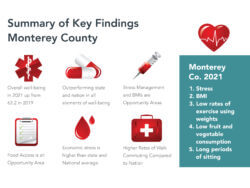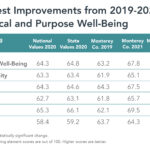May 24, 2022

Transforming Monterey County, California, with Co-opetition
Creating Cooperative Relationships with Traditional Competitors
Examples abound: Apple and Samsung; DHL and UPS; Ford and GM, Google and Yahoo; Russia and the U.S. on space exploration. [1]
Transform or Perish An ongoing, successful example of co-opetition focused on healthcare and prevention is found in Monterey County, CA, where Montage Health, Salinas Valley Memorial Healthcare System (SVMH), and Taylor Farms are committed to a common purpose — making a difference in the community they serve.
Traditionally, businesses near each other might vie for the attention of potential clients — patients, in the case of healthcare systems. But these two neighboring providers added value for their patients, community and subsequently themselves by collaborating.
Co-Opetition Defined
Co-opetition[2], the act of cooperating on some common activities, such as prevention or wellness, while competing on market share or scarce resources, is very effective. Simply stated, the two complementary goals for potential partners-competitors are first to grow the pie, and second to equitably divide the larger pie. Increasing involvement among all the participants is easier if an abundance of opportunities and/or resources exists. Thus, growing the pie precedes dividing the pie.
Collaborate, Add Value or Compete and Incur Cost
Collaborating, competing, compromising, accommodating, and avoiding are five major ways of relating according to the Thomas-Kilmann Conflict Mode Instrument.[3] These behaviors, used in dealing with others, form part of a person’s personality. An institution’s culture is also partially defined by these behaviors. The five relations can combine in many ways when people or institutions agree to collaborate and/or compete.
However, conscientiously moving towards the positive spectrum of the Thomas-Kilmann Conflict Mode Instrument, namely collaborating, not only accelerates progress but also can become self-sustaining. Collaborating adds value to both the collaborators and those being served. Competing, compromising, accommodating, and avoiding add cost, decrease value, and burn up or waste limited resources.
Two contradictory, polarizing quotes come to mind. Gore Vidal’s malicious quote, “It is not enough to succeed. Others must fail,” contrasts with Bernard Baruch’s optimistic statement, “You don’t have to blow out the other fellow’s light to let your own shine.”
In healthcare, actions should always be positive. Competition does not have to destroy the opposition; the goal is to do well and help others. Building complementary capabilities helps everyone, thus the importance of the new, sixth mode of interaction — co-opetition.
A Perfect Example
Montage Health and Salinas Valley Memorial Healthcare System (SVMH), knowing the demographics of the population, partnered on a Medicare Advantage program. Together they created a countywide diabetes initiative, and a population health company. They both agreed that working together improves patients’ health, thus requiring less care, while the entire community and their respective healthcare systems also benefit. Decreasing the cost of healthcare for Medicare Advantaged, managed Medicaid, and self-insured patients fulfills both altruistic and financial goals.
The third noteworthy partner, Taylor Farms, is one of the largest produce growers in America and has been a pillar in the region for generations. Becoming a major sponsor of Monterey County’s adopted prevention plan was a natural extension of the Taylor family’s desire to help its community’s well-being, while also controlling healthcare expenditures for its self-insured medical plan.

Collaborating on common goals conserves limited resources, demonstrates enviable behavior, and produces better outcomes. Trust, a necessary catalyst, grows with success as a virtuous cycle. Having the common goal of a healthy community with healthy citizens is not unique. What is unusual in Salinas is the cooperation among two major, very successful healthcare systems and a responsible multigenerational family.
SVMH CEO Pete Delgado and Montage Health CEO Dr. Steven Packer already met monthly to work on common concerns and the Medicare Advantage program. When the opportunity occurred in Salinas to join a recognized national prevention program, with consideration to extend across Monterey County, the dialogue and trust already existed. The wonderful support of Taylor Farms created a community poised for success.
Although enthusiastic supporters for prevention abound, not many success stories for entire communities exist. Monterey County chose a successful program that has demonstrated effectiveness across seventy communities, including over 4.5 million people and over 5,000 organizations.
“Co-opetition is the perfect approach for the healthcare industry to avoid the destruction of much that is essential to the continuing health of the American people. It should be required reading by managers of healthcare providers and health insurance or HMO managers.” In this introductory quote to Co-opetition by Adam Brandenburger and Barry Nalebuff, former COO of Memorial Sloan-Kettering Cancer Center John Gunn suggests that healthcare providers and organizations will thrive by capturing an overlooked opportunity to serve patients and communities.
The costs of marketing, branding, and image-building, along with redundancies of facilities and services as well as other pricey endeavors to attract patients, all accelerate the expense of healthcare in America without improving quality, access, or prevention. These “wasted resources” should create motivation to change from the current acquisition and consolidation model to co-opetition.
Metrics Matter
Sharing best practices helps everyone, particularly when healthcare systems and their communities have been stressed by initially the pandemic and now the great resignation. The comprehensive, proven program focused on people, places, and policy adopted by SVMH and Montage Health resulted in significant improvements for approximately 350,000 diverse folks across the socioeconomic spectrum after two years, as shown in the charts.

Monterey didn’t experience the downward trends seen across the nation during the pandemic. Rather Monterey continued:
- Thriving in life evaluation.
- Getting recognition for improving the area where they live.
- Enjoying support from family and friends.
- Receiving encouragement to be healthy.

These changes extend over the entire community — not just the already healthy neighborhoods. Monterey County’s Social Determinants of Health score now exceeds the nation’s but lags slightly behind California’s. Residents in this county worry less about money than in other regions, although not having enough money to do what they want remains a problem.
Co-Opetition Makes Sense When:
- Saving costs and avoiding duplication of effort for complex development.
- Capitalizing on each other’s areas of special expertise.
- If your organization doesn’t cooperate with another entity, both will be worse off.
- If you do cooperate, the combination will be more effective than either alone.
Future Care
Improving the health of a community decreases expenditures for care. This financially advantageous approach makes sense as payment migrates, albeit slowly, from fee-for-service to value. An excellent area for cooperation by multiple healthcare systems is prevention, which eliminates many chronic care costs. Everyone benefits — patients avoid illness, caregivers experience satisfaction, and providers mitigate loss.
The U.S., the best in the world for acute care, is among the worst in managing more expensive chronic care. Capitation payment for those in Medicare Advantage (approximately one-third of Medicare participants), managed Medicaid, and self-insured employer plans is perfectly aligned with prevention because healthier participants require less care.
Diabetes and pre-diabetes affect over 40 percent of Americans with an even higher incidence in Monterey. Within the next decade, over 50 percent of Americans are expected to be overweight or obese. The starting rate was 66% in Monterey. Cancer will affect one third of people. Heart disease remains the leading cause of death. All these diseases can be mostly prevented or effectively treated with long-term programs focused on prevention.
In sum, co-opetition, effective in many industries, now also works in healthcare. Competing on market share and brand recognition doesn’t save lives —prevention does. Cooperating on helping people stay healthy is both ethically sound and financially prudent for systems that have otherwise, in the past, been at odds keeping beds full and clinics busy.
Sources
-
“The Rules of Co-opetition,” Adam Brandenburger and Barry Nalebuff, HBR, Jan 2021.
-
“Co-opetition,” Adam Brandenburger and Barry Nalebuff, 1997.
-
“Thomas-Kilmann Instrument,” Kenneth W. Thomas and Ralph H. Kilmann, 1974.





